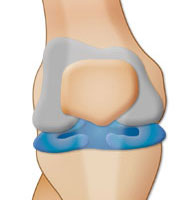
Diagram of the knee joint showing the meniscal cartilage
Press release issued: 23 August 2012
Meniscal tears are suffered by over one million people a year in the US and Europe alone. Meniscal tears currently only have the potential to heal if they are located in the peripheral edge of the meniscus which has a blood supply. Ninety per cent or more of tears currently are therefore not amenable to repair. Instead, treatment usually involves removal of the damaged part of the meniscus, however this surgery is strongly correlated with development of osteoarthritis several years later.
Azellon Ltd, (“Azellon”),
a spin-out from the University of Bristol and the developer of stem cell therapies for tissue repair, today announced that recruitment had commenced for the phase I/IIa trial of its Cell Bandage for knee meniscus repair.
Built upon the pioneering work of Professor Anthony Hollander from the University’s School of Cellular and Molecular Medicine, the Azellon procedure takes stem cells, harvested from the patient’s own bone marrow, grows them on a structural bio-scaffold, and two weeks later implants the newly created Cell Bandage into the patient’s knee.
Meniscal tears are suffered by over one million people a year in the US and Europe alone. Meniscal tears currently only have the potential to heal if they are located in the peripheral edge of the meniscus which has a blood supply. Ninety per cent or more of tears currently are therefore not amenable to repair. Instead, treatment usually involves removal of the damaged part of the meniscus, however this surgery is strongly correlated with development of osteoarthritis several years later.
Azellon’s Cell Bandage is designed to enable the tear to repair itself by encouraging cell growth in the affected tissue. This technique is similar to the windpipe transplant that saved the life of Claudia Castillo in 2008, a project in which Professor Hollander was closely involved.
Professor Hollander commented “People have been aware of our work for some time and many have offered to take part in the trial. Up to now we’ve had to turn them away whilst we developed the process and sought the necessary regulatory approvals. I’m delighted we are now ready to go.”
The Cell Bandage trial is a Phase I/IIa clinical study at Southmead Hospital in Bristol under the supervision of Professor Ashley Blom. This “first-in-man” study for 18- to 45-year-old volunteer patients has a primary objective of evaluating the safety of Cell Bandage in the treatment of meniscal tears. The Cell Bandage trial will run throughout the second half of this year, with preliminary results expected by the middle of 2013.
Further information
*Meniscal tears are broken into two groups. One group is where the meniscal tear is in the outer margins, the so-called vascularised or red zone. These tears are likely to repair by simply reducing the tear with sutures or meniscal fixators which will promote good clinical outcome. This group is believed to be between ten per cent and 20 per cent of all meniscal tears. The other group, representing 80 per cent to 90 per cent, consists of the tears to the avascularised or so-called white zone. Due to the absence of blood supply, these tears are unlikely to heal using sutures or meniscal fixators and are thus either partially or fully removed. Partial or full removal of the meniscus (menisectomy) can provide significant pain relief within three to five months in most patients. It is, however, also well documented that four to six years after menisectomy, osteoarthritic changes are noticeable in the knee of many patients, often leading to further joint surgery including total knee replacement.
About Azellon
Azellon is a spin-out company from the University of Bristol that was co-founded by Professor Anthony Hollander and is backed by a syndicate of investors including IP Group plc, Oxford Technology Management, Wyvern Seed Fund and Hugh Osmond. Professor Hollander came to national prominence as part of the academic team that saved the life of Claudia Castillio, after developing the first tissue-engineered trachea (windpipe) using the patient’s own stem cells. This fully functioning airway was transplanted into the patient and saved her life. Azellon’s focus is on developing stem cell therapy for the repair of avascular meniscal tears. Azellon has received grant funding from the Wellcome Trust and the Technology Strategy Board. For more information, please visit www.azellonctx.com
About Cell Bandage
Azellon’s technology is based on harvesting adult stem cells from the iliac chest, expanded under GMP conditions and in-seeding an increased population of the patient’s own cells into a membrane. This membrane is surgically inserted, using mini arthrotomy, into the tear in the meniscus where it is fixed by suture. Once in place, the newly implanted cells will communicate with the original cells. This communication is inductive for cells migrating between the implant and the original tissue leading to bridging or welding of the tear. This is expected to lead to strong and long term repair without removing any tissue and thus avoiding the osteoarthritic changes in knee joints and subsequent further surgery.
